
|
 |
 |
Fire | Car | Plane | Ship Martin Verhoef runs a lifeboat company called the Verhoef Aluminum Scheepsbouw, located in the Netherlands. It specializes in the totally enclosed, free-fall lifeboat, which is designed to get passengers quickly and safely away from danger, from sinking ships to burning off-shore oil rigs. Verhoef has had an interest in lifeboats since he was a child, when his father ran the same company. NOVA: Tell us about your father's childhood and his interest in ships. Verhoef: Well, I remember from my father that he kept track of all the ship disasters during his childhood. And he had a kind of driving force to know exactly what was going on. Funnily enough, later on he used all that information by building the safest lifeboats ever designed. NOVA: When did he start his company? Verhoef: In 1941. At first he just made pots and pans of aluminum. But, shortly after World War II he designed the first aluminum lifeboats, which were sold to a Norwegian ship owner. During the following years, he built up quite a reputation. Worldwide, people knew who we were. Because of this reputation we came in contact with a Dutch ship owner, who asked us to design a lifeboat that was safer than anything ever built before. He had escaped twice from a shipwreck, and he didn't want to go for a third time. So my father looked at all the areas that needed improvement. The first one, of course, was the need to get quickly away from the ship as safely as possible. Traditionally a lifeboat is launched by two wires. But doing this in rough weather conditions is very dangerous. That's why he decided to release the lifeboat from the stern of the ship by means of a cradle. The advantage is that you are only depending on gravity. It's no longer a case of: Are the wires strong enough? Will the winds cooperate? The release mechanism has to be operated, and that's it. Gravity does the job. Once this boat is launched, it immediately clears the area into the safe area. And it doesn't take more than a few seconds.
Verhoef: It was quite a revolution when my father designed this lifeboat in the early 1960s, because you have to bear in mind that in those days, lifeboats were still open. Now, to launch an open lifeboat is quite a risky job, especially if you have high seas and stormy conditions. This lifeboat was entirely covered, so that people were no longer exposed to environmental conditions, like a fire or a storm. The free-fall lifeboat met the toughest requirements you can think of. So we were really hoping that we would get orders for more free-fall lifeboats. But the opposite was true. We had to wait 20 more years. When my father tried to promote the use of the free-fall lifeboat, he became very disappointed. People discussed the price and the use of it. He was very committed to market his free-fall lifeboat, because he knew that people could be saved at sea if there was a need for it. I remember that after a discussion with a ship owner, who was almost heading toward the use of free-fall lifeboats, and in the end turned him down, he said, "You will mark my words, you'll need another disaster before you go ahead with this free-fall lifeboat." What we did in the meantime, especially my father, was to try to improve everything about the lifeboat that we had previously made in 1960.
Verhoef: After 25 years of improvement, my father eventually came up with a good design. It's launched quickly, and it can be launched even from high heights, like 80 feet or more. It maintains its forward motion purely because of its special sharp-shaped design. So, within seconds, you are at least 330 feet away from the [oil] platform. It's self-righting, so that no matter what condition the boat enters the water in, it always rights itself automatically. At that time, legislation didn't require anything. So it was a revolution for this free-fall lifeboat to be self-righting in all circumstances.
During a fire you can't open the windows, of course, so that's why we also have our own air supply inside the lifeboat. So besides the engine, you have the water spray system, but you also have the air supply. And it is enough for 10 minutes of sailing at a speed of six knots. NOVA: When did you first start supplying lifeboats for oil platforms? Verhoef: I would say early 1980s. It's interesting to note that when oil platforms were developed, nobody knew what kind of safety systems would be needed. They simply went to the shipping inspectors and said, "Well, aboard ships we're using this kind of lifeboat. So let's put those similar lifeboats on the platform." In many locations in the world, that's not a bad idea. When the sea is calm, and there are no frozen or icy conditions, then it's no problem to jump into the water. But in other places there are very, very difficult environmental conditions for which it's very dangerous to use conventional systems. When it's very cold with high winds, a lot of waves and so on, it's very dangerous. You simply need another kind of evacuation system. So our newer boats can be launched from high heights like 100 feet, without having high acceleration forces. NOVA: When did you start getting customers for these free-fall lifeboats for oil platforms? Verhoef: Sadly enough, the Piper Alpha disaster really led to a big breakthrough for our free-fall lifeboats. [In 1988, the Piper Alpha oil platform exploded in the North Sea, and many oil workers were killed.] From that point on, people were aware that there was an immediate need for safer evacuation systems, an evacuation system that could be used from high heights like 100 feet and over.
Verhoef: In the case of an emergency, people are trained to board a lifeboat as quickly as possible. These aluminum free-fall lifeboats are designed to get 45 people safely away from any hazards, like a platform or a ship. So they simply go to the far end of the boat, take their seat, and when they all do it simultaneously the aisle is completely free for the new range of people. Using this procedure, it only takes three minutes to board the lifeboat completely. The boat is released hydraulically. One person could easily do it, but we have chosen to have it be done by two people in order to avoid the possibility this lifeboat is launched by someone who simply wants to get away from the platform. So one person operates the launching pump, and the second one has to simultaneously operate the launching valve. By doing this together, the hydraulic pressure is built up and the release mechanism is activated.
NOVA: Do you supply any lifeboats to passenger ships, such as cruise ships? Verhoef: No, not at all. The design of today's cruise ships does not allow the mounting of a free-fall lifeboat at the stern of the ship. There are so many people on board that you would need to have free-fall lifeboats projected on each ship's side. That takes a lot of space and has a high cost. Today, still, safety is as high as people want to pay. NOVA: Or until another accident happens. Verhoef: Yes. I think that a tragedy like the Titanic could be repeated. The majority of people on board ships are there for the first time. They don't know how to react in a panic situation. There are so many open ends that it's still dangerous.
Verhoef: The next challenge will be a launching system for lifeboats from an airplane. We found that a free-fall lifeboat on board could be very valuable in some areas when the wind is too high and the waves are too high. So, by simply dropping a free-fall lifeboat out of the plane, you could offer more safety, more assistance. NOVA: From what height could you safely drop a free-fall lifeboat? Verhoef: Well, presently we're doing drops over 330 feet using a parachute. The work takes a long time. We are cooperating with Clemson University in South Carolina, but everything depends on financial support. If we succeed in developing such a system, there will only be a very small market for it. We've talked to NASA, and they've been very interested. Although I must admit that every time the budgets are cut, things slow down. NOVA: Is it inevitable that we have to put a financial limit on how much we're willing to spend to reduce risk? Do companies wind up having to put a value on people's lives? Verhoef: Well, I think at least one of our duties in trying to achieve the best kind of evacuation system is to target yourself to almost zero risk. Once it appears that it's possible to meet, then the industry, engineers, and so on, they are in a way challenged to see whether they can meet the level in spite of the fact that there is no real financial support for anything like that.
Verhoef: I would always try to get as much information as you can get today in the way of casualties and so on—to get a clear picture of what the needs are for a new system. If you want to do something that you can market, to convince people that it's much safer, then at least you have to have the knowledge of what kind of casualties happened in the past. It's also very important that you listen to the operators, to the people who want to use the evacuation system. You can only do that if you have been on board ships for a couple of weeks or on an oil platform. You have to have the connection with reality. Otherwise you design something that is of no end use. Escape Through Time | Skydive | Human Response Survivor Stories | Pioneers of Survival | Survival Strategies Resources | Teacher's Guide | Transcripts | Site Map | Escape! Home Editor's Picks | Previous Sites | Join Us/E-mail | TV/Web Schedule About NOVA | Teachers | Site Map | Shop | Jobs | Search | To print PBS Online | NOVA Online | WGBH © | Updated November 2000 |
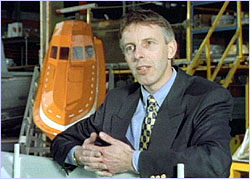 Martin Verhoef
Martin Verhoef
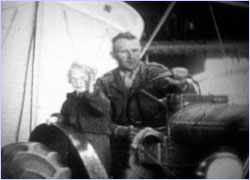 Martin Verhoef, left, with his father, a
ground-breaking lifeboat engineer.
Martin Verhoef, left, with his father, a
ground-breaking lifeboat engineer.
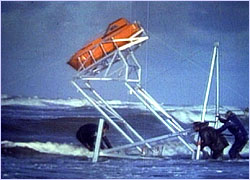 Early tests on this life boat demonstrated that it
was self-righting and reliable.
Early tests on this life boat demonstrated that it
was self-righting and reliable.
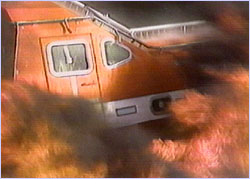 Verhoef's lifeboat could even withstand
flames—the temperature inside this boat only
reached 85° F throughout its test by fire.
Verhoef's lifeboat could even withstand
flames—the temperature inside this boat only
reached 85° F throughout its test by fire.
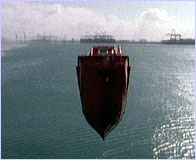 Verhoef's free fall lifeboat swiftly slides from its
lodging on an oil platform...
Verhoef's free fall lifeboat swiftly slides from its
lodging on an oil platform...
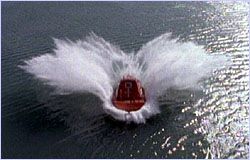 ...and gracefully dives into the ocean
...and gracefully dives into the ocean
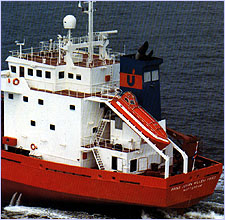 Freefall lifeboats can now be mounted on other ships.
Freefall lifeboats can now be mounted on other ships.
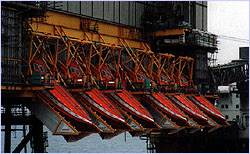 Freefall lifeboats were installed on the
Piper Bravo platform.
Freefall lifeboats were installed on the
Piper Bravo platform.